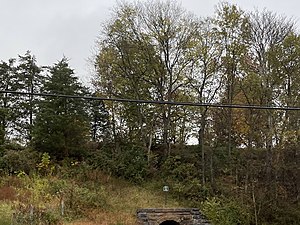| Wreck at the Fat Nancy | |
|---|---|
 The site of accident as it appears in 2022, the trestle replaced with a culvert. | |
| Details | |
| Date | July 12, 1888[1] morning[1] |
| Location | Orange County, Virginia[1] |
| Country | United States |
| Line | Virginia Midland Railroad[1] |
| Incident type | Trestle collapse[1] |
| Statistics | |
| Trains | 1[1] |
| Deaths | 9[1] |
| Injured | 26[1] |
The Wreck at the Fat Nancy was one of the largest railroad disasters in Virginia's history. On the morning of July 12, 1888, the incident occurred when a trestle collapsed as a passenger train was atop it.[2] Virginia Midland Railroad's Train 52—"The Piedmont Airline"—was crossing the 44-foot-high (13 m), 487-foot-long (148 m) trestle known as the "Fat Nancy" when it gave way, sending the train to the ground.
By 1888, many states had experienced memorable wrecks with high death tolls. Though Virginia newspapers were full of reports of small train accidents, there were typically few deaths. The wreck at Fat Nancy was Virginia's first experience with a train crash that resulted in multiple deaths and large-scale injuries. Five passengers, one rail employee, one mail clerk, and one newsboy were killed and another mail clerk died from his injuries the following day. At least twenty-six were injured, though some reports list a higher number.[3]
The incident is named for the trestle, known as the "Fat Nancy" for the woman who served as the trestle watcher.[1] The trestle's official name was Browning Trestle, for the owners of the property on which it sits, or Two-Runs trestle for the creek that ran below. A local African-American woman who waved to train conductors and occasionally received a shovelful of coal inspired locals to rename the trestle as Fat Nancy's trestle. The Baltimore Sun reported that the woman's actual name was Emily Jackson and described a woman of "great size and uncouth appearance."[4]
One of the deceased was Cornelius G. Cox, the civil engineer who had designed a culvert to replace the trestle, which was known to be unstable.[2] After the collapse, the area was filled with earth and a granite culvert placed over the stream, per his design.[5] One of the surviving passengers was former Confederate Lieutenant General James Longstreet, who was returning from the 25th reunion of the Battle of Gettysburg.[1][2]
The culvert that replaced the trestle still stands today, where it allows Laurel Creek to flow through.[6] Tracks no longer cross the culvert—they're now to the south.[6] The Virginia Department of Historic Resources erected a historical marker at the site of the wreck, along Virginia State Route 20, in 2007.[2] A keystone at the top of the arched tunnel is marked "In memory of Cornelius Cox."
References
[edit]- ^ a b c d e f g h i j Maurer, David (2009-01-04). "Man's luck got tested, and tested..." The Daily Progress. Media General. Retrieved December 18, 2010.
- ^ a b c d "Wreck at the Fat Nancy". Retrieved 2010-12-18.
Here, on 12 July 1888, occurred one of Virginia's largest train disasters, the wreck of the Virginia Midland Railroad's Train 52, the Piedmont Airline, as it crossed the 44-foot-high, 487-foot-long trestle, called the Fat Nancy for a local African American woman who served as trestle watcher and reported problems, the trestle collapsed. Nine passengers were killed, including two Confederate veterans, and more than two dozen were injured. Also killed was civil engineer Cornelius G. Cox, who had earlier designed the current culvert and earthen fill to replace the unstable trestle. Former Confederate Lt. Gen. James Longstreet, another passenger, survived.
- ^ Virginia Railroad Commissioner, Annual Report of the railroad commissioner of the state of Virginia, 1888-1889 (Richmond, Va: R.F. Walker, Superintendent of Public Printing, 1889): xi.
- ^ The Baltimore Sun. July 13, 1888.
{{cite news}}: Missing or empty|title=(help) - ^ "Local Brevities". Alexandria Gazette. November 24, 1888. p. 3. Retrieved September 23, 2019.
- ^ a b Swain, Craig. "Wreck at the Fat Nancy". The Historical Marker Database. Retrieved 2010-12-18.
- "Another Terrible Accident" (PDF). Alexandria Gazette. July 12, 1888. p. 2. Retrieved 2020-12-14.